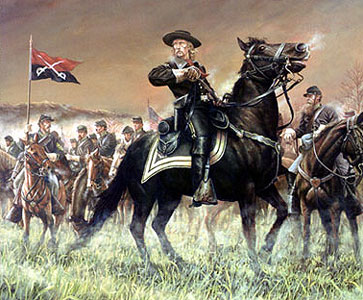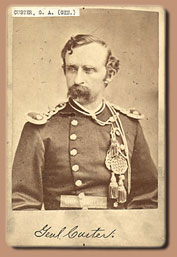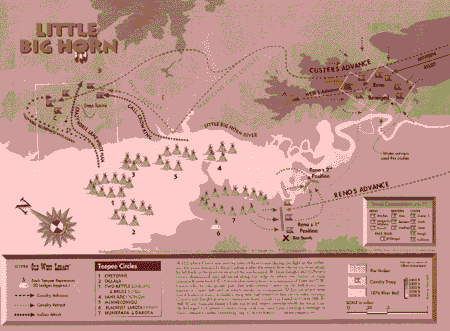| When
gold was found in the Black Hills of Dakota territory 1874, a war between
the U.S Army and the Sioux Indians was unavoidable. The Black Hills was
a sacred place to many Tribes and was placed off-limits to all white settlements
by the Fort Laramie Treaty of 1868, which said that "No
white person or persons shall be permitted to settle or occupy any protion
of territory, or without the consent of the Indians to pass through same".
In return the Indians were not surpose to oppose the constroctions of
some railroad connections, or to worry the settlers, or take prisoners
and so on. The Indians kept their part of the agridment but the whiteīs
didnīt.
 The
news of the goldfindings in the Black Hills spread fast and led to an
increasing of prospectors into the Dakota territory and to attacks on
the prospectors by the Sioux under chiefs Sitting Bull, Crazy Horse
and Gall. When the Goverments efforts to purchase the Black Hills faild,
they put the Fort Laramie Treaty aside and all Indians not settled in
reservations by January 31 1876 was considered hostile. But instead
of returning to the reservations the Indians joined up with Sitting
Bulls camp in the valley of Little Big Horn. Now all the agreement were
forgoten, and the goverment decided that the Indians had to be punished
for disobey orders and not turning up at the reservations. They new
the Indians were gathering northwest of the Black Hills, and that Sitting
Bull was the head leader. Therefore they planed to attack from several
directions at the same time, but the planes were postponed because
of the hard winter weather. When the Spring came the Army troops started
to move out, one of the Units were led by General Alfred H. Terry and
in Terrys Unit were also the 7th US Cavalry regement led by Colonel
George Armstrong Custer. The
news of the goldfindings in the Black Hills spread fast and led to an
increasing of prospectors into the Dakota territory and to attacks on
the prospectors by the Sioux under chiefs Sitting Bull, Crazy Horse
and Gall. When the Goverments efforts to purchase the Black Hills faild,
they put the Fort Laramie Treaty aside and all Indians not settled in
reservations by January 31 1876 was considered hostile. But instead
of returning to the reservations the Indians joined up with Sitting
Bulls camp in the valley of Little Big Horn. Now all the agreement were
forgoten, and the goverment decided that the Indians had to be punished
for disobey orders and not turning up at the reservations. They new
the Indians were gathering northwest of the Black Hills, and that Sitting
Bull was the head leader. Therefore they planed to attack from several
directions at the same time, but the planes were postponed because
of the hard winter weather. When the Spring came the Army troops started
to move out, one of the Units were led by General Alfred H. Terry and
in Terrys Unit were also the 7th US Cavalry regement led by Colonel
George Armstrong Custer.
 After
a long hard month of marching Terry arrived at the estuary of the Rosebud
river. He sent out scouts who located the Sioux at the Little Big Horn
River. Terry sent out a unit from the 7th US cavalry led by Custer southwest
up on the hills, while himself would make a flanking movment with canons
and footsoldiers, the arrangements was to surround the Indians and
crush them by united effort at the Little Big Horn River. After 3 days
Custer and his men were closing in to the enormous camp at the valley
of Little Big horn River. Unaware of the Indians strengh, bettwen 2500-4000
men. Custer disregarded the arrangements to join Terry at the junction
of the Big Horn and Little Big Horn river, and prepared to attack at
once. The unit were split up in tree divisions, two flanking colums
and one frontal-assault force with about 265 men under his personal
command. They were surpose to attack the Indian camp from several directions
at the same time. Custer obstinate attack ended catastriphicley, he
and his men fought desperatly but all were killed to the last man. The
other two divisons sufered difficult casualtys. Later Terrys tropps
relived the remainder of the regeiment. After
a long hard month of marching Terry arrived at the estuary of the Rosebud
river. He sent out scouts who located the Sioux at the Little Big Horn
River. Terry sent out a unit from the 7th US cavalry led by Custer southwest
up on the hills, while himself would make a flanking movment with canons
and footsoldiers, the arrangements was to surround the Indians and
crush them by united effort at the Little Big Horn River. After 3 days
Custer and his men were closing in to the enormous camp at the valley
of Little Big horn River. Unaware of the Indians strengh, bettwen 2500-4000
men. Custer disregarded the arrangements to join Terry at the junction
of the Big Horn and Little Big Horn river, and prepared to attack at
once. The unit were split up in tree divisions, two flanking colums
and one frontal-assault force with about 265 men under his personal
command. They were surpose to attack the Indian camp from several directions
at the same time. Custer obstinate attack ended catastriphicley, he
and his men fought desperatly but all were killed to the last man. The
other two divisons sufered difficult casualtys. Later Terrys tropps
relived the remainder of the regeiment.
 After
the battle of Little Big Horn all the Indians dispersed, it is true
they had defeated "Long hair" as the called Custer but they
also new that their time was over, they new that they couldent resist
the whites any longer. Many thousands more cavalry men were sent out
to this area, and over the next year they recentiessly pursued the Indians
who had split up after Custers fight, forcing chief after chief to surrender. After
the battle of Little Big Horn all the Indians dispersed, it is true
they had defeated "Long hair" as the called Custer but they
also new that their time was over, they new that they couldent resist
the whites any longer. Many thousands more cavalry men were sent out
to this area, and over the next year they recentiessly pursued the Indians
who had split up after Custers fight, forcing chief after chief to surrender.
There
has been may speculations over why Custer did what he did. Some consider
that he didnīt had a choice because of dim orders, but most people are
convinsed that it was his love of adventure who drove him to it, that
it was a desperet try to gain a lost popularity.
|

 The
news of the goldfindings in the Black Hills spread fast and led to an
increasing of prospectors into the Dakota territory and to attacks on
the prospectors by the Sioux under chiefs Sitting Bull, Crazy Horse
and Gall. When the Goverments efforts to purchase the Black Hills faild,
they put the Fort Laramie Treaty aside and all Indians not settled in
reservations by January 31 1876 was considered hostile. But instead
of returning to the reservations the Indians joined up with Sitting
Bulls camp in the valley of Little Big Horn. Now all the agreement were
forgoten, and the goverment decided that the Indians had to be punished
for disobey orders and not turning up at the reservations. They new
the Indians were gathering northwest of the Black Hills, and that Sitting
Bull was the head leader. Therefore they planed to attack from several
directions at the same time, but the planes were postponed because
of the hard winter weather. When the Spring came the Army troops started
to move out, one of the Units were led by General Alfred H. Terry and
in Terrys Unit were also the 7th US Cavalry regement led by Colonel
George Armstrong Custer.
The
news of the goldfindings in the Black Hills spread fast and led to an
increasing of prospectors into the Dakota territory and to attacks on
the prospectors by the Sioux under chiefs Sitting Bull, Crazy Horse
and Gall. When the Goverments efforts to purchase the Black Hills faild,
they put the Fort Laramie Treaty aside and all Indians not settled in
reservations by January 31 1876 was considered hostile. But instead
of returning to the reservations the Indians joined up with Sitting
Bulls camp in the valley of Little Big Horn. Now all the agreement were
forgoten, and the goverment decided that the Indians had to be punished
for disobey orders and not turning up at the reservations. They new
the Indians were gathering northwest of the Black Hills, and that Sitting
Bull was the head leader. Therefore they planed to attack from several
directions at the same time, but the planes were postponed because
of the hard winter weather. When the Spring came the Army troops started
to move out, one of the Units were led by General Alfred H. Terry and
in Terrys Unit were also the 7th US Cavalry regement led by Colonel
George Armstrong Custer. After
a long hard month of marching Terry arrived at the estuary of the Rosebud
river. He sent out scouts who located the Sioux at the Little Big Horn
River. Terry sent out a unit from the 7th US cavalry led by Custer southwest
up on the hills, while himself would make a flanking movment with canons
and footsoldiers, the arrangements was to surround the Indians and
crush them by united effort at the Little Big Horn River. After 3 days
Custer and his men were closing in to the enormous camp at the valley
of Little Big horn River. Unaware of the Indians strengh, bettwen 2500-4000
men. Custer disregarded the arrangements to join Terry at the junction
of the Big Horn and Little Big Horn river, and prepared to attack at
once. The unit were split up in tree divisions, two flanking colums
and one frontal-assault force with about 265 men under his personal
command. They were surpose to attack the Indian camp from several directions
at the same time. Custer obstinate attack ended catastriphicley, he
and his men fought desperatly but all were killed to the last man. The
other two divisons sufered difficult casualtys. Later Terrys tropps
relived the remainder of the regeiment.
After
a long hard month of marching Terry arrived at the estuary of the Rosebud
river. He sent out scouts who located the Sioux at the Little Big Horn
River. Terry sent out a unit from the 7th US cavalry led by Custer southwest
up on the hills, while himself would make a flanking movment with canons
and footsoldiers, the arrangements was to surround the Indians and
crush them by united effort at the Little Big Horn River. After 3 days
Custer and his men were closing in to the enormous camp at the valley
of Little Big horn River. Unaware of the Indians strengh, bettwen 2500-4000
men. Custer disregarded the arrangements to join Terry at the junction
of the Big Horn and Little Big Horn river, and prepared to attack at
once. The unit were split up in tree divisions, two flanking colums
and one frontal-assault force with about 265 men under his personal
command. They were surpose to attack the Indian camp from several directions
at the same time. Custer obstinate attack ended catastriphicley, he
and his men fought desperatly but all were killed to the last man. The
other two divisons sufered difficult casualtys. Later Terrys tropps
relived the remainder of the regeiment. After
the battle of Little Big Horn all the Indians dispersed, it is true
they had defeated "Long hair" as the called Custer but they
also new that their time was over, they new that they couldent resist
the whites any longer. Many thousands more cavalry men were sent out
to this area, and over the next year they recentiessly pursued the Indians
who had split up after Custers fight, forcing chief after chief to surrender.
After
the battle of Little Big Horn all the Indians dispersed, it is true
they had defeated "Long hair" as the called Custer but they
also new that their time was over, they new that they couldent resist
the whites any longer. Many thousands more cavalry men were sent out
to this area, and over the next year they recentiessly pursued the Indians
who had split up after Custers fight, forcing chief after chief to surrender.
 bravenet.com
bravenet.com